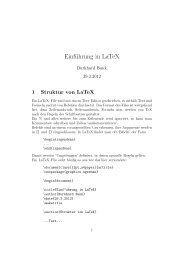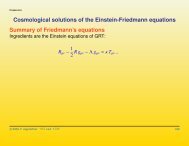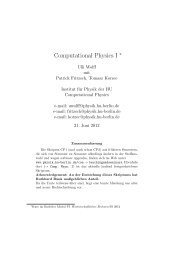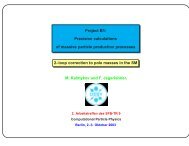Preprint[pdf] - HU Berlin
Preprint[pdf] - HU Berlin
Preprint[pdf] - HU Berlin
Create successful ePaper yourself
Turn your PDF publications into a flip-book with our unique Google optimized e-Paper software.
a) b) c)<br />
Fig. 14. Light–by–light scattering insertions in the electromagnetic vertex.<br />
that closed fermion loops with three photons vanish by Furry’s theorem. Again, besides the equal mass case<br />
mloop = mµ there are two different regimes for electron and tau loops [143,144], respectively:<br />
• Light internal masses also in this case give rise to potentially large logarithms of mass ratios which get<br />
singular in the limit mlight → 0<br />
µ<br />
γ<br />
e<br />
γ’s<br />
a (6)<br />
µ (lbl, e) =<br />
� 2<br />
3 π2 ln mµ<br />
me<br />
+ 59<br />
270 π4 − 3 ζ(3)<br />
− 10<br />
3 π2 + 2<br />
� �� �α<br />
me<br />
+ O<br />
3 π<br />
mµ<br />
ln mµ<br />
me<br />
This again is a light loop which yields an unexpectedly large contribution<br />
a (6)<br />
µ (lbl, e) ≃ 20.947 924 89(16)<br />
� α<br />
π<br />
� 3<br />
= 2.625 351 02(2) × 10 −7 , (81)<br />
with the error from the (me/mµ) mass ratio. Historically, it was calculated first numerically by Aldins et<br />
al. [69], after a 1.7 σ discrepancy with the CERN measurement [67] in 1968 showed up.<br />
Again, for comparison we also consider the<br />
• equal internal masses case, which yields a pure number<br />
µ<br />
γ<br />
μ<br />
γ’s<br />
a (6)<br />
�<br />
5 5<br />
µ (lbl, µ) = ζ(5) −<br />
6 18 π2 ζ(3) − 41<br />
540 π4 − 2<br />
3 π2 ln 2 2<br />
+ 2<br />
3 ln4 2 + 16a4 − 4<br />
3 ζ(3) − 24π2 ln 2 + 931<br />
54 π2 + 5<br />
� �α<br />
9 π<br />
and has already been included in the universal part Eq. (51). The constant a4 is defined in Eq. (A.14). The<br />
single scale QED contribution is much smaller<br />
a (6)<br />
µ (lbl, µ) ≃ 0.371005293<br />
�<br />
α<br />
�3 = 4.64971652 × 10<br />
π<br />
−9 , (82)<br />
but is still a substantial contributions at the required level of accuracy.<br />
• Heavy internal masses again decouple in the limit mheavy → ∞ and thus only yield small power corrections<br />
µ<br />
γ<br />
τ<br />
γ’s<br />
Numerically we obtain<br />
a (6)<br />
µ (lbl, τ) =<br />
a (6)<br />
µ (lbl, τ) ≃ 0.002 142 83(69)<br />
� �3<br />
2<br />
� �<br />
19 mµ<br />
ζ(3) −<br />
16<br />
mτ<br />
� 2<br />
+ O<br />
� m 4 µ<br />
m 4 τ<br />
� 3<br />
.<br />
ln 2 mτ<br />
mµ<br />
� 3<br />
,<br />
�� �α<br />
�<br />
α<br />
�3 = 2.685 56(86) × 10<br />
π<br />
−11 . (83)<br />
This contribution could play a role in a next generation precision experiment only. The error indicated is<br />
from the (mµ/mτ) mass ratio.<br />
All other corrections follow from Fig. 10 by replacing at least one muon in a loop by another lepton or<br />
quark. The corresponding mass dependent corrections are of particular interest because the light electron<br />
32<br />
π<br />
� 3<br />
.


![Preprint[pdf] - HU Berlin](https://img.yumpu.com/3833433/32/500x640/preprintpdf-hu-berlin.jpg)




